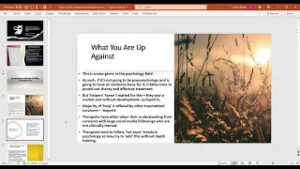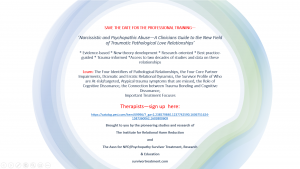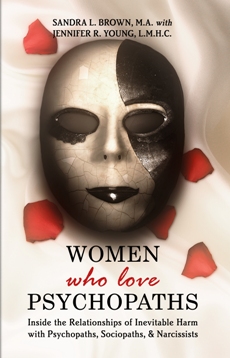Remember the line ‘You’re known by the company you keep’? Well, I don’t think that ONLY includes the pathological and dangerous man…it also includes your ‘friends’ and ‘family’ members who are emotional accomplices of his.
Someone wrote me this week and said “Please write about this–when your own friends don’t get how sick he is and think you should go back or they think you’re over exaggerating his faults.”
There’s a couple of things to consider here…first of all, your patterns of selection of dangerous, pathological, or not quite healthy people probably exceed just your intimate relationship selections–it might include your friends, cohorts, buddies, and even bosses. Women who enter recovery for pathological relationships and attend the retreats quickly figure out that their lives are LOADED with other pathological people! Not just him! That’s because those super traits in you I write about are just as active in ALL your relationships as they are in your intimate ones. So don’t be surprised to find these types of people hidden out in all corners of your life. Many women realize they got some house cleaning to do in terms of clearing out all the unhealthy people from their lives once they recognize what pathology is and WHO it’s in…
Secondly, the dangerous and pathological people often attract people to them. If your friends and family members have your emotional characteristics, they are likely to STILL see him how you USE to see him…they haven’t been hurt up close and personal by him to ‘get it’ the way you do. Since these are Jekyll and Hyde guys, they have one face for you and another adorable and charming one for everyone else, including friends and family. Women get confused when they gauge whether they should be with him based on what OTHERS say about him. Intimate relationships are just that—PRIVATE and others don’t see him behind closed doors the way you do/did. Their take on this charming charismatic guy doesn’t include everything your gut has told you about him…
When you are ending the relationship, he’s likely to pour it on to all your family and friends—the tears, the confusion and shoulder shrugging (“What did I do?”) and pleading (“Help me get her back!”). Those family and friends who have those same HIGH traits of empathy, tolerance, and compassion are likely to fall for it. Top it off, that almost all the pathologicals also proclaim to be ‘sick or dying’ when the relationship is ending and you have a cheering squad who has lined up to back up his sad and pleading stories.
Then there’s the ‘finding religion’ guys who go to your pastor/rabbi and blow the dust off their Bible and are sitting in the front row of church week after week telling your pastor how ‘unforgiving’ you are of him.
Yup. Your friends are likely to point to all that pew-sitting and think there’s something to it. But YOU know better…you’ve seen it all before. The core of pathology is they aren’t wired to sustain positive change so this too shall pass…
Getting confused about what ‘other’ people think of him goes back to the central issue of you having ignored your red flags when you met him. Don’t ignore them again when people who haven’t got a clue what true pathology is tells you that you should ‘give it one more shot.’ You know what you know. Tell yourself the truth. Then turn to them…and tell them too. It’s called psychopathy education–teach what you know!
(**Information about pathological love relationships is in our award winning book Women Who Love Psychopaths and is also available in our retreats, 1:1s, or phone sessions. See the website for more info.)








